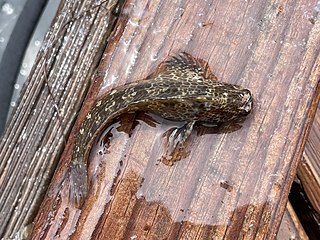
Echinolittorina paytensis is a species of sea snail, a marine gastropod mollusk in the family Littorinidae, the winkles or periwinkles.

Hypsoblennius is a genus of combtooth blennies found in the Pacific and Atlantic Oceans.

Hypsoblennius brevipinnis, commonly known as the barnaclebill blenny, is a species of combtooth blenny found on coral reefs in the eastern-central Pacific Ocean. This species grows to a length of 12 centimetres (4.7 in) TL.

Hypsoblennius caulopus, the tidepool blenny, is a species of combtooth blenny found among rocky reefs of the eastern Pacific ocean. This species grows to a length of 9 centimetres (3.5 in) TL.
Hypsoblennius exstochilus, commonly known as the longhorn blenny, is a species of combtooth blenny found in the western-central Atlantic Ocean. This species grows to a length of 5 centimetres (2.0 in) TL.

Hypsoblennius gentilis, commonly known as the bay blenny, is a species of combtooth blenny found in the eastern-central Pacific Ocean. This species grows to a length of 15 centimetres (5.9 in) TL.

Hypsoblennius gilberti, commonly known as the rockpool blenny, is a species of combtooth blenny found in the eastern Pacific Ocean. This species grows to a length of 17 centimetres (6.7 in) TL. The specific name honours the American ichthyologist Charles H. Gilbert (1859-1928).

Hypsoblennius hentz, the feather blenny, is a species of combtooth blenny found in coral reefs in the western Atlantic ocean. This species grows to a length of 10 centimetres (3.9 in) total length. The feather blenny can be found in the western Atlantic Ocean. They range from Nova Scotia, Canada to Texas along the North American shore. Often, feather blenny can be found in oyster reefs and rocky shores. The identity of the person honoured in this species' specific name is uncertain but it is thought that to have been the French American arachnologist Nicholas Marcellus Hentz (1797-1856) who is the "Mr Hentz" from Charleston, North Carolina who sent the type to Lesueur.

Hypsoblennius invemar, commonly known as the tessellated blenny, is a species of combtooth blenny found in the western Atlantic Ocean.

Hypsoblennius ionthas, commonly known as the freckled blenny, is a species of combtooth blenny found in the western Atlantic Ocean.

Hypsoblennius jenkinsi, commonly known as the mussel blenny, is a species of combtooth blenny found in the eastern-central Pacific Ocean. This species grows to a length of 13 centimetres (5.1 in) TL. The specific name honours Oliver Peebles Jenkins (1850-1935), who was professor of physiology at Stanford University.
Hypsoblennius maculipinna is a species of combtooth blenny, which is found in the shallow coastal waters of the eastern Pacific from Costa Rica to Ecuador and which usually measures about 6.2 centimetres (2.4 in).
Hypsoblennius proteus, commonly known as the Socorro blenny, is a species of combtooth blenny found in the eastern central Pacific Ocean. It is endemic to the waters around the island of Socorro in the Revillagigedo Islands of Colima state in western Mexico.
Hypsoblennius robustus is a species of combtooth blenny found in the south-eastern Pacific Ocean, from the Gulf of Guayaquil in southern Ecuador and Peru. This species grows to a length of 3.9 centimetres (1.5 in) SL.

Hypsoblennius sordidus is a species of combtooth blenny found in the south-eastern Pacific Ocean, from Lima, Peru south to Chile. This species grows to a length of 11.6 centimetres (4.6 in) TL.
Hypsoblennius striatus, commonly known as the striated blenny, is a species of combtooth blenny found in coral reefs in the eastern-central Pacific Ocean, around Costa Rica and Panama. This species grows to a length of 8 centimetres (3.1 in) TL.

The World's 25 Most Endangered Primates is a list of highly endangered primate species selected and published by the International Union for Conservation of Nature (IUCN) Species Survival Commission (SSC) Primate Specialist Group (PSG), the International Primatological Society (IPS), Global Wildlife Conservation (GWC), and Bristol Zoological Society (BZS). The IUCN/SSC PSG worked with Conservation International (CI) to start the list in 2000, but in 2002, during the 19th Congress of the International Primatological Society, primatologists reviewed and debated the list, resulting in the 2002–2004 revision and the endorsement of the IPS. The publication was a joint project between the three conservation organizations until the 2012–2014 list when BZS was added as a publisher. The 2018–2020 list was the first time Conservation International was not among the publishers, replaced instead by GWC. The list has been revised every two years following the biannual Congress of the IPS. Starting with the 2004–2006 report, the title changed to "Primates in Peril: The World's 25 Most Endangered Primates". That same year, the list began to provide information about each species, including their conservation status and the threats they face in the wild. The species text is written in collaboration with experts from the field, with 60 people contributing to the 2006–2008 report and 85 people contributing to the 2008–2010 report. The 2004–2006 and 2006–2008 reports were published in the IUCN/SSC PSG journal Primate Conservation,, since then they have been published as independent publications.
Lamelliconcha is a genus of molluscs in the subfamily Callocardiinae of he family Veneridae.











